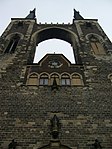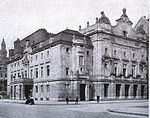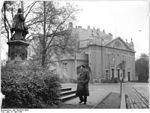Bernhard Sehring
Bernhard Sehring (born June 1, 1855 in Edderitz , Anhalt ; † December 27, 1941 in Berlin ; full name: Ernst Bernhard Sehring ) was a German architect .
Life
Sehring came from a middle-class, rural environment and was the son of a Dessau site manager. He retired to Professor Happach and attended grammar school and art school in Dessau. From 1873 to 1875 he studied at the Braunschweig Polytechnic , then four semesters of architecture at the Berlin Building Academy . During his studies he became a member of the Academic Association Motiv . In the years 1877/1878 he was an intern with the architect Karl Hoene in Halle (Saale) . Bernhard Sehring served his military service year as a one-year volunteer in 1878/1879. In 1879/1880 he undertook a study trip to Italy to examine the local theater architecture and garden architecture.
Shortly after he was accepted into the Berlin Architects' Association, he received the Schinkel Prize in 1882, his first architecture prize for his designs for the Berlin Museum Island . In 1883 he received the Great Academic State Prize .
As a state scholarship holder in Rome (1883 and 1884), he took part in an international theater building competition for the first time and opened the Peters und Sehring architectural office in Berlin-Kreuzberg with Ernst Peters . In 1889 he ended this partnership and from 1890 worked as a freelance artist and architect.
Sehring became known for his designs, especially competition designs, theaters and other new buildings. At first he even ran the Theater des Westens in Berlin-Charlottenburg as a GmbH with his partner Paul Blumenreich; however, the attempt was financially unsuccessful. 1907–1921 he built the Roseburg near Ballenstedt ( Harz ) as his family's summer residence .
Buildings and designs
- 1889–1890: Künstlerhaus St. Lukas in Berlin, Fasanenstrasse 13 (under monument protection )
- 1890–1895: House at Kantstrasse 153 in Berlin-Charlottenburg ( Rudolf Diesel's first residence )
- 1891 (?): Queen Luise Memorial Hall in Neustrelitz
- 1892: Couple of multi-family houses in Berlin, Carmerstrasse 10/11
- 1895–1896: Theater des Westens in Berlin-Charlottenburg, Kantstrasse
- 1895–1896: west towers of St. Jakob Church in Köthen (Anhalt)
- 1895–1896: Theater "Alt-Berlin" at the Berlin trade exhibition in Berlin-Treptow in 1896 (canceled in 1897)
- 1899–1900: Facade of the H. & C. Tietz AG department store in Berlin, Leipziger Strasse 46–49 (destroyed in World War II)
- 1901: Walpurgishalle on Hexentanzplatz near Thale (Harz)
- 1902–1904: Stadttheater in Bielefeld , Niederwall 27 (interior changed in 1937, renovated 2004–2006 in accordance with listed buildings)
- 1903–1904: Villa " Löwenpalais " in Berlin-Grunewald, Koenigsallee 30/32 (under monument protection)
- 1904–1905: Schauspielhaus in Düsseldorf, Kasernenstrasse (destroyed in World War II)
- 1904–1905: City Theater in Halberstadt (destroyed in World War II)
- 1905: Bismarck Fountain in Breslau , Schlossplatz / Königsplatz
- 1906–1910: City Hall / Music Hall in Görlitz , Am Stadtpark 1
- 1907–1908: City Theater (today's State Theater ) in Cottbus , Schillerplatz
- 1907–1920: Roseburg near Ballenstedt , Sehring's summer residence
- before 1914: Expansion of Schloss Reisen
- before 1914: Conversion of the “Wintergarten” variety theater in Berlin, Friedrichstrasse
- 1927–1928: Delphi-Palast cinema in Berlin-Charlottenburg, Kantstrasse / Fasanenstrasse (heavily damaged in World War II, facade and garden design reconstructed)
literature
- Ralph Berndt: Bernhard Sehring and the Roseburg . An ensemble of late historicism in the Harz. In: Die Gartenkunst 11 (1/1999), pp. 22–29.
Web links
- Sehring's biography and catalog raisonné on the Roseburg website , last accessed on April 19, 2012
- Holdings on Bernhard Sehring in the Architekturmuseum der Technische Universität Berlin , last accessed on April 19, 2012
Individual evidence
- ↑ The Black Ring. Membership directory. Darmstadt 1930, p. 39.
- ^ Directory of the award-winning competition designs for the Schinkel Prize. In: Wochenschrift des Architekten-Verein zu Berlin , 6th year 1911, No. 10 (from March 11, 1911), p. 54, accessed on January 11, 2020.
- ↑ Centralblatt der Bauverwaltung , 3rd year 1883, No. 47 (from November 24, 1883) ( online ), p. 434.
| personal data | |
|---|---|
| SURNAME | Sehring, Bernhard |
| ALTERNATIVE NAMES | Sehring, Ernst Bernhard (full name) |
| BRIEF DESCRIPTION | German architect |
| DATE OF BIRTH | June 1, 1855 |
| PLACE OF BIRTH | Edderitz , Anhalt |
| DATE OF DEATH | December 27, 1941 |
| Place of death | Berlin-Charlottenburg |









